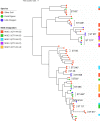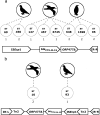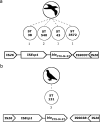Implications of Foraging and Interspecies Interactions of Birds for Carriage of Escherichia coli Strains Resistant to Critically Important Antimicrobials
- PMID: 32801178
- PMCID: PMC7531969
- DOI: 10.1128/AEM.01610-20
Implications of Foraging and Interspecies Interactions of Birds for Carriage of Escherichia coli Strains Resistant to Critically Important Antimicrobials
Abstract
Globally, gulls have been associated with carriage of high levels of Escherichia coli strains resistant to critically important antimicrobials (CIAs), a major concern, as these antimicrobials are the sole alternative or one among only a few alternatives available to treat severe life-threatening infections in humans. Previous studies of Australian silver gulls demonstrated high levels of resistance to CIAs, particularly fluoroquinolone and extended-spectrum cephalosporins, among E. coli strains (carriage at 24% and 22%, respectively). This study aimed to identify and characterize strains from four distinct bird species inhabiting a common coastal environment, determine the frequency of carriage of CIA-resistant E. coli strains, and examine if these resistant clones and their resistance-encoding mobile genetic elements (MGEs) could be transmitted between species. CIA-resistant E. coli was detected in silver gulls (53%), little penguins (11%), and feral pigeons (10%), but not in bridled terns. In total, 37 different sequence types (STs) were identified, including clinically significant human-associated lineages, such as ST131, ST95, ST648, ST69, ST540, ST93, ST450, and ST10. Five main mobile genetic elements associated with blaCTX-M-positive E. coli strains isolated from three bird species were detected. Examination of clonal lineages and MGEs provided indirect evidence of transfer of resistance between bird species. The carriage of CIA-resistant E. coli by gulls and pigeons with proximity to humans, and in some instances food-producing animals, increases the likelihood of further bidirectional dissemination.IMPORTANCE It has been shown that 20% of Australian silver gulls carry drug-resistant Escherichia coli strains of anthropogenic origin associated with severe diseases, such as sepsis and urinary tract infections, in humans. To further characterize the dynamics of drug-resistant E. coli in wildlife populations, we investigated the carriage of critically important antimicrobial (CIA) drug-resistant E. coli in four bird species in a common environment. Our results indicated that gulls, pigeons, and penguins carried drug-resistant E. coli strains, and analysis of mobile genetic elements associated with resistance genes indicated interspecies resistance transfer. Terns, representing a bird species that forages on natural food sources at sea and distant from humans, did not test positive for drug-resistant E. coli This study demonstrates carriage of CIA-resistant bacteria in multiple bird species living in areas commonly inhabited by humans and provides further evidence for a leapfrog effect of resistance in wildlife, facilitated by feeding habits.
Keywords: Antimicrobial resistance; CTX-M; Escherichia coli; ST131; bird; gulls; mobile genetic elements; penguins; pigeons.
Copyright © 2020 American Society for Microbiology.
Figures





Similar articles
-
Resistance to critically important antimicrobials in Australian silver gulls (Chroicocephalus novaehollandiae) and evidence of anthropogenic origins.J Antimicrob Chemother. 2019 Sep 1;74(9):2566-2574. doi: 10.1093/jac/dkz242. J Antimicrob Chemother. 2019. PMID: 31287537
-
Proximity to human settlement is directly related to carriage of critically important antimicrobial-resistant Escherichia coli and Klebsiella pneumoniae in Silver Gulls.Vet Microbiol. 2023 May;280:109702. doi: 10.1016/j.vetmic.2023.109702. Epub 2023 Feb 17. Vet Microbiol. 2023. PMID: 36848814
-
The gull (Chroicocephalus brunnicephalus) as an environmental bioindicator and reservoir for antibiotic resistance on the coastlines of the Bay of Bengal.Microb Drug Resist. 2014 Oct;20(5):466-71. doi: 10.1089/mdr.2013.0233. Epub 2014 Apr 30. Microb Drug Resist. 2014. PMID: 24786256
-
The CTX-M conundrum: dissemination of plasmids and Escherichia coli clones.Microb Drug Resist. 2011 Mar;17(1):83-97. doi: 10.1089/mdr.2010.0132. Epub 2011 Jan 31. Microb Drug Resist. 2011. PMID: 21281129 Review.
-
Are we overestimating risk of enteric pathogen spillover from wild birds to humans?Biol Rev Camb Philos Soc. 2020 Jun;95(3):652-679. doi: 10.1111/brv.12581. Epub 2020 Jan 31. Biol Rev Camb Philos Soc. 2020. PMID: 32003106 Free PMC article. Review.
Cited by
-
F Plasmid Lineages in Escherichia coli ST95: Implications for Host Range, Antibiotic Resistance, and Zoonoses.mSystems. 2022 Feb 22;7(1):e0121221. doi: 10.1128/msystems.01212-21. Epub 2022 Jan 25. mSystems. 2022. PMID: 35076267 Free PMC article.
-
Molecular Epidemiology of Fosfomycin Resistant E. coli from a Pigeon Farm in China.Antibiotics (Basel). 2021 Jun 25;10(7):777. doi: 10.3390/antibiotics10070777. Antibiotics (Basel). 2021. PMID: 34202219 Free PMC article.
-
The Role of Gulls as Reservoirs of Antibiotic Resistance in Aquatic Environments: A Scoping Review.Front Microbiol. 2021 Jul 23;12:703886. doi: 10.3389/fmicb.2021.703886. eCollection 2021. Front Microbiol. 2021. PMID: 34367104 Free PMC article.
-
High Prevalence of Beta-Lactam-Resistant Escherichia coli in South Australian Grey-Headed Flying Fox Pups (Pteropus poliocephalus).Microorganisms. 2022 Aug 7;10(8):1589. doi: 10.3390/microorganisms10081589. Microorganisms. 2022. PMID: 36014007 Free PMC article.
-
Opportunistic Gulls Infected by Antibiotic-Resistant Bacteria Show Contrasting Movement Behaviour.Ecol Evol. 2025 Apr 15;15(4):e71257. doi: 10.1002/ece3.71257. eCollection 2025 Apr. Ecol Evol. 2025. PMID: 40235727 Free PMC article.
References
-
- Abraham S, O'Dea M, Sahibzada S, Hewson K, Pavic A, Veltman T, Abraham R, Harris T, Trott DJ, Jordan D. 2019. Escherichia coli and Salmonella spp. isolated from Australian meat chickens remain susceptible to critically important antimicrobial agents. PLoS One 14:e0224281. doi:10.1371/journal.pone.0224281. - DOI - PMC - PubMed
-
- WHO. 2018. WHO critically important antimicrobials for human medicine, 6th revision. World Health Organization, Geneva, Switzerland: https://www.who.int/foodsafety/areas_work/antimicrobial-resistance/cia/en/. Accessed 21 May 2020.
-
- Costa D, Poeta P, Sáenz Y, Vinué L, Rojo-Bezares B, Jouini A, Zarazaga M, Rodrigues J, Torres C. 2006. Detection of Escherichia coli harbouring extended-spectrum β-lactamases of the CTX-M, TEM and SHV classes in faecal samples of wild animals in Portugal. J Antimicrob Chemother 58:1311–1312. doi:10.1093/jac/dkl415. - DOI - PubMed
MeSH terms
LinkOut - more resources
Full Text Sources
Medical

